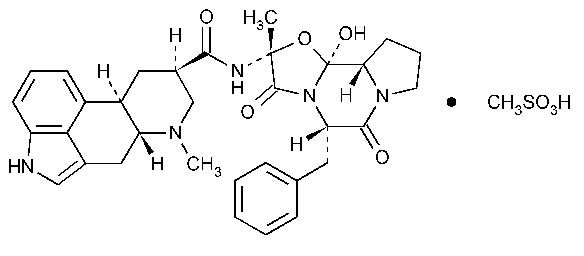Dihydroergotamine Mesylate
Ergotaman-3¢,6¢,18-trione,9,10-dihydro-12¢-hydroxy-2¢-methyl-5¢-(phenylmethyl)-,(5¢a)-,monomethanesulfonate (salt).
Dihydroergotamine monomethanesulfonate [6190-39-2].
»Dihydroergotamine Mesylate contains not less than 97.0percent and not more than 103.0percent of C33H37N5O5·CH4O3S,calculated on the dried basis.
Packaging and storage—
Preserve in well-closed,light-resistant containers.
Identification—
A:
Infrared Absorption á197Kñ.
B:
Ultraviolet Absorption á197Uñ—
Solution:
50µg per mL.
Medium:
70%alcohol.
Absorptivities at 280nm,calculated on the dried basis,do not differ by more than 3.0%.
C:
The principal spot from the Test preparationfound in the test for Related alkaloidscorresponds in RFvalue to that obtained from the Standard preparation.
Specific rotation á781Sñ:
between -16.7 and -22.7
and -22.7 .
.
Test solution:
25mg per mL,in a mixture of chloroform,alcohol,and ammonium hydroxide (10:10:1).
pHá791ñ:
between 4.4and 5.4,in a solution (1in 1000).
Loss on drying á731ñ—
Dry it in vacuum at 100 to constant weight:it loses not more than 4.0%of its weight.
to constant weight:it loses not more than 4.0%of its weight.
Related alkaloids—
Solvent mixture—
Mix 10volumes of chloroform,10volumes of methanol,and 1volume of ammonium hydroxide.
Test solution—
Prepare a solution of Dihydroergotamine Mesylate in Solvent mixtureto contain 20mg per mL.
Standard solution
and Standard dilutions—Prepare a solution of USP Dihydroergotamine Mesylate RSin Solvent mixtureto contain 20mg per mL(Standard solution).Prepare a series of dilutions of the Standard solutionin Solvent mixtureto contain 0.40mg,0.20mg,and 0.10mg per mL(Standard dilutions).
Procedure—
In a suitable chromatographic chamber arranged for thin-layer chromatography place a volume of a solvent system consisting of a mixture of chloroform and alcohol (9:1)sufficient to develop the chromatogram,cover,and allow to equilibrate for 30minutes.Apply 5-µLportions of the Test solution,the Standard solution,and each of the three Standard dilutionsto a suitable thin-layer chromatographic plate coated with a 0.25-mm layer of chromatographic silica gel.Allow the spots to dry,and develop the chromatogram until the solvent front has moved about three-fourths of the length of the plate.Remove the plate from the developing chamber,mark the solvent front,and allow the solvent to evaporate.Locate the spots on the plate by lightly spraying with a solution prepared by dissolving 800mg of p-dimethylaminobenzaldehyde in a cooled mixture of 80g of alcohol and 20g of sulfuric acid.The RFvalue of the principal spot obtained from the Test solutioncorresponds to that obtained from the Standard solution.Estimate the concentration of any other spots observed in the lane for the Test solutionby comparison with the Standard dilutions.The spots from the 0.40-,0.20-,and 0.10-mg-per-mLdilutions are equivalent to 2.0%,1.0%,and 0.50%of impurities,respectively.The sum of the impurities is not greater than 2.0%.
Assay—
Standard preparation—
Transfer about 10mg of USP Dihydroergotamine Mesylate RS,accurately weighed,to a 200-mLvolumetric flask,add 2mLof methanol,dilute with tartaric acid solution (1in 100)to volume,and mix.
Assay preparation—
Using about 10mg of Dihydroergotamine Mesylate,accurately weighed,prepare as directed for Standard preparation.
Procedure—
Transfer 3.0mLeach of the Standard preparation,the Assay preparation,and tartaric acid solution (1in 100)to provide the blank,to separate conical flasks.Add 6.0mLof p-dimethylaminobenzaldehyde TSto each,shake,and allow to stand for 20minutes.Concomitantly determine the absorbances of the solutions in 1-cm cells at the wavelength of maximum absorbance at about 585nm,with a suitable spectrophotometer,against the blank.Calculate the quantity,in mg,of C33H37N5O5·CH4O3Sin the portion of Dihydroergotamine Mesylate taken by the formula:
0.2C(AU/AS),
in which Cis the concentration,in µg per mL,of USP Dihydroergotamine Mesylate RSin the Standard preparation,and AUand ASare the absorbances of the solutions from the Assay preparationand the Standard preparation,respectively.
Auxiliary Information—
Staff Liaison:Ravi Ravichandran,Ph.D.,Senior Scientist
Expert Committee:(PA3)Pharmaceutical Analysis 3
USP28–NF23Page 648
Pharmacopeial Forum:Volume No.29(6)Page 1870
Phone Number:1-301-816-8330
